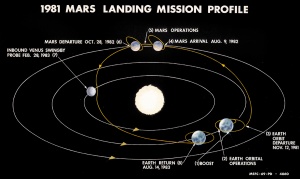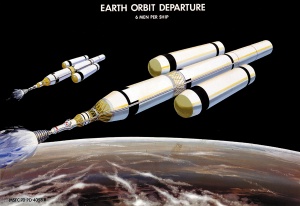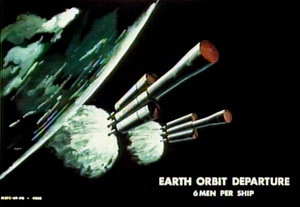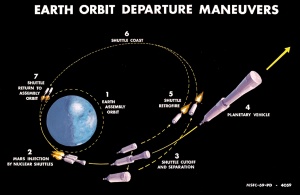Manned Mars Landing by Wernher von Braun Pt 1
From The Space Library
PRESENTATION TO THE SPACE TASK GROUP - By Dr. Wernher von Braun - Aug 4 1969
Contents |
INTEGRATED PROGRAM
With the recent accomplishment of the manned lunar landing, the next frontier is manned exploration of the planets. Perhaps the most significant scientific question is the possibility of extraterrestrial life in our solar system. Manned planetary flight provides the opportunity to resolve this universal question thus capturing international interest and cooperation.
The information presented here describes a method of landing man on the planet Mars in 1982. The scientific goals of the mission are described and the key decision dates are identified. The unmanned planetary missions described in Part 1 are critical to the final designs selected.
The 1981 manned Mars mission (1982 landing on Mars) is shown as an integral part of the total space program for the next two decades. The systems and experience resulting from the Apollo program and the missions proposed for the 1970's provide the technical and programmatic foundation for this undertaking. A 1982 manned Mars landing is a logical focus for the programs of the next decade.
Although the undertaking of this mission will be a great national challenge, it represents no greater challenge than the commitment made in 1961 to land a man on the moon.
MANNED PLANETARY MISSION - 1981 MARS LANDING MISSION PROFILE
1981 Mars Landing Mission Profile
Several different modes are possible for accomplishing Mars landing missions, each with its peculiar advantages and disadvantages. The typical Mars Landing Mission begins with the boost of the planetary vehicle elements into Earth orbit (1) utilizing the Saturn V and Space Shuttle vehicles. Following assembly of the complete planetary vehicle in Earth orbit (2), the Earth departure phase of the mission is initiated (3). The Mars vehicle then begins a 270 day journey to Mars. This is by no means an idle phase of the mission. In addition to observations of Mars, many other experiments and measurements will be made on both the Earth to Mars and Mars to Earth legs of the trip that are of prime scientific importance. The spacecraft represents a manned laboratory in space, free of the disturbing influences of the Earth. The fact that there will be two observation points, Earth and the spacecraft, permits several possible experiments regarding the temporal and spatial features of the interplanetary environment. In addition, the spacecraft can be used to supplement and extend numerous observations conducted from Earth orbital space stations, particularly in the field of astronomy. It is possible, for example, that as yet unidentified comets might be observed for the first time.
Upon arriving at Mars, the space ship is propulsively braked into orbit (4) in the same fashion that the Apollo moon ship is placed into lunar orbit. The ship remains in Mars orbit for about 80 days (5), during which time the Mars Surface Sample Return (MSSR) probes and the Mars Excursion Modules (MEM) are deployed and the surface exploration takes place. At the end of the Mars capture period, the spacecraft is boosted out of Mars orbit (6). The return leg of the trip lasts about 290 days, during which many experiments and observations are again conducted. A unique feature of the homeward trip is a close encounter with Venus (7), about 120 days after departing Mars. Probes will be deployed at Venus during this passage, in addition to the radar mapping measurements that will be made.
The approximate two year journey ends with the return to Earth orbit (8), and following medical examinations the crew will be returned to Earth via a Space Shuttle.
EARTH ORBIT DEPARTURE
The Mars Landing Mission can be accomplished with a single planetary vehicle assembled in Earth orbit. There are, however, advantages in deploying two ships on the mission because of the long duration. One obvious advantage is crew safety, each spacecraft being designed to accept the crew of the sister ship in the event of a major failure. This approach also allows more exploration equipment to be carried on the expedition and enhances the probability of achieving mission objectives.
In the current concept, each vehicle assembled in earth orbit consists of three nuclear propulsion modules (Nuclear Shuttles) side by side, with the planetary spacecraft docked to the center module. Each spacecraft is nominally capable of sustaining a crew of six people for two years, or a crew of twelve for an extended period, in case of emergency.
The earth orbit departure maneuver is initiated with the firing of the outer two propulsion modules as illustrated.
Earth Orbit Departure (1970)
Earth Orbit Departure (1969)
EARTH ORBIT DEPARTURE MANEUVERS
The two planetary vehicles are assembled in a circular Earth orbit. Each vehicle consists of a spacecraft, two nuclear shuttle vehicles for Earth departure propulsion, and one nuclear shuttle for the remaining propulsion requirements through the Mars mission.
Following assembly and checkout in Earth orbit, each of the planetary ships is accelerated by the two outer nuclear shuttles to trans Mars injection velocity. The two outer nuclear shuttles are then shut down, separated from the planetary vehicle, oriented for retro fire, and then retro fired to place them on a highly elliptic path returning to the original assembly orbit altitude. After a coast of several days, the nuclear shuttles arrive at the original assembly orbit altitude and are retro fired again to place them into a circular orbit. The nuclear shuttles rendezvous with a space station to be checked out and refueled for further utilization.
The nuclear shuttles which return to Earth orbit will be available for transfer of fuel and supplies to geosynchronous orbit or to lunar orbit.
Earth Orbit Departure Maneuvers)




